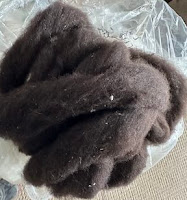I went over my friend's to try out her new huge electric carder. It's double width at least of a home carder and has dual speed adjustments for the licker-in and the main drum. She's worked out a spiffy way to draft off roving instead of batts, using a little bead as a diz. It works amazingly well and the resulting roving is very professionally done. It's light, fluffy, and easy to spin.
I brought the last of my bag of merino/cashmere/silk/nylon mill ends which were too hard to spin without processing. I'd been hand carding them, but was frustrated enough to think about digging out my drum carder, when this play date came up. It took a while, because it's still a fairly slow process, but what an amazing job. I think we ran them through 3 times and we ended up processing just over 300g, into 3 huge bumps which filled 1/3 of a large plastic bin bag. It was beautiful stuff.
I'd actually brought the mill ends in case we needed something else to card, as we were going to work on the black guild fleece. The guild fleeces have turned into a rant worthy project. I was away on holiday, so someone took my place on the field trip, to get the fleeces we were offered. I'm hoping they didn't have a choice because that would make things much more acceptable. We were supposed to get 5 fleeces, but the gal picking them up took one. That's fine, because 4 fleeces is a lot of work so spreading the load is a good thing. These are the fleeces that I was told weren't for me to work with during the summer and if they needed my help, they'd ask. "Whatever"...still ticked me off, as I had the time and space to work with them then. Anyway, in the fall, I got the rest of them as the person gatekeeping them decided she was tired of them and going to store them in a warm, dark spot - moth haven.
The first fleece we had access to was washed by someone with little experience. She was happy with her efforts, but there was still so much lanolin in it. Plus with just a gentle tug, we found that a good part of the fleece had a break in it. If you take a lock of the fleece with one end in each hand and give a tug on it, the fleece should hold together. With a break in it, it will snap into two shorter pieces. It's an unsound fleece and horrible to work with. After you check the staple length, this is the next test to do, in several places. Not only that but parts of the fleece were felted. A thinks that both issues are due to dunking and lifting a mesh bag of fleece during washing, instead of letting it soak openly. So A took it home to rewash, and see what she could do with it. She ended up trying to card it, then comb it and almost gave up. With the new carder, she made something useable but only after running it through the electric carder 5 times! It's a nice-ish knitting yarn, very rustic due to the ness, in a worsted/aran weight.
The second fleece is also white but I washed some up with multiple washes and rinses. I couldn't hand card it. Literally was too compacted or felted to hand card. It was a miserable mess on a small drum carder with coarse cloth. I had to comb it and it was about 70% loss of fleece to useable fibre. Not only that but it was hard on the hands, so not worth it at all. I gave the washed fibre to A too see what her thoughts were and she couldn't get anything good out of it either.
The third fleece is a lamb's fleece with so much lanolin that 5 washings with soap and degreaser still left the fleece greasy. I figured another wash would felt it up, just from overworking it, so I left it with A to see what she could do with it. I'm sort of wondering if it should just be turned into compost because no fleece is worth that much time, effort and resources to process.
The last fleece was the black one. Of them all, it's by far the best. Apparently someone washed it
before I got it, but that was the one that required 3 more washings and 3 rinses to actually get it clean. We carded up just over 200g, into two bumps to see what our thoughts were for spinning this. I'm half through my bit. It spins up fairly easily. There are many more neps than I'd like in it and not all can be picked out when spinning. This means it's a lot thicker yarn than I'd normally spin with something like this. It's full of vm, way more than I'd anticipated.
Also, if someone gives you fleeces or you buy them, you have the right to check them to make sure they are worth the amount of work needed to make them into useable yarn. I've gotten fleeces from the Canadian Wool Co-op and straight from the farm which required only a couple of washes and rinses to bring up bright, easy to use fibre with almost no vm. They can be a joy to work with. Before you put your money down, you should be able to check the staple length and the integrity of the locks before you buy, or at least have an honest description from the seller.



No comments:
Post a Comment